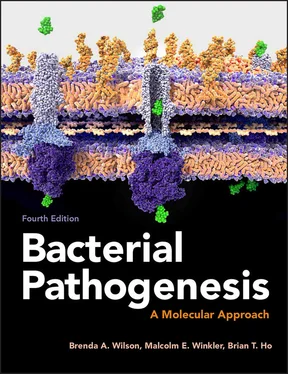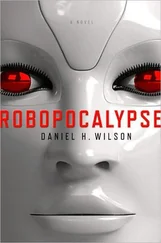Adaptive Defense Systems in Nonmammals
The Dark Side of the Adaptive Defenses: Autoimmune Disease
Selected Readings
Questions
Solving Problems in Bacterial Pathogenesis
CHAPTER 5 The Microbiota of the Human Body: Microbiomes and Beyond
Importance of the Normal Resident Microbial Populations (Microbiota) of the Human Body
Characterization of the Body’s Microbiota
Taking a Microbial Census by Using Microbial rRNA Gene Sequence Analysis
Characterizing Microbiomes by Using Metagenomic Analysis
Beyond the Metagenome
Overview of the Human Microbiota
Skin Microbiota
Oropharyngeal Microbiota
Microbiota of the Small Intestine and Colon
Microbiota of the Vaginal Tract
The Other Microbiota: The Forgotten Eukaryotes
Selected Readings
Questions
Solving Problems in Bacterial Pathogenesis
CHAPTER 6 Microbes and Disease: Establishing a Connection
History and Relevance of Koch’s Postulates
Early Germ Theory
Koch’s Postulates: A Set of Criteria Used To Establish a Microbe-Disease Connection
Challenges to Satisfying Koch’s Postulates
Easier Said than Done …
The First Postulate: Association of the Microbe with Lesions of the Disease
The Second Postulate: Isolating the Bacterium in Pure Culture
The Third Postulate: Showing that the Isolated Bacterium Causes Disease Experimentally in Humans or Animals
The Fourth Postulate: Reisolating the Bacterium from the Intentionally Infected Animal
Modern Alternatives To Satisfy Koch’s Postulates
Detecting the Presence of the Pathogen Only in Diseased Tissues
Eliminate the Pathogen and Prevent or Cure the Disease
Comparative Infectious Disease Causation
The Microbiota Shift Disease Problem
Koch’s Postulates and Pathogenic Microbial Communities
Keystone Pathogens and Microbial Shift Diseases
Molecular Koch’s Postulates
Concepts of Disease
Varieties of Human-Microbe Interactions
Views of the Human-Microbe Interaction
Virulence as a Complex Phenomenon
Selected Readings
Questions
Solving Problems in Bacterial Pathogenesis
CHAPTER 7 Mechanisms of Genetic Modification and Exchange: Role in Pathogen Evolution
Adapt or Perish
Acquiring New Virulence Traits by Horizontal Gene Transfer
Mechanisms of Genetic Change and Diversification
Spontaneous Mutation
Phase Variation
Antigenic Variation
Horizontal Gene Transfer: Mobile Genetic Elements
Natural Transformation
Conjugation: Plasmids and Transposons
Phage Transduction
Control of Horizontal Gene Transfer
Toxin-Antitoxin Systems—Retaining the Goods
Restriction-Modification Systems—Bacterial Innate Immunity from Foreign DNA
CRISPR-Cas Systems—Bacterial Adaptive Immunity from Foreign DNA
Type 6 Secretion Systems—Bacterial Defense Against Conjugation
Pathogenicity Islands and Pathogen Evolution
Properties of Pathogenicity Islands
Pathogen Evolution in Quantum Leaps
Selected Readings
Questions
Solving Problems in Bacterial Pathogenesis
CHAPTER 8 Identification of Virulence Factors: Measuring Infectivity and Virulence
How Does One Experimentally Measure Virulence and Satisfy Koch’s Postulates?
Animal Models of Infection
Human Volunteers
Nonhuman Animal Models
Measuring Bacterial Infection in Animal Models
Ethical Considerations
Animal Model Basics
Survival Curve Analysis and Biophotonic Imaging
ID50 and LD50 Values
Competition Assays
Tissue Culture and Organ Culture Models
Tissue Culture Models
Gentamicin Protection Assay for Cell Adhesion and Invasion
Plaque Assay for Intracellular Survival and Cell-to-Cell Spread
Fluorescence Microscopy Techniques for Assessing Effects of Pathogens on Host Cells
Organ Culture Models
The Continuing Need for Reliable and Plentiful Information about Disease Pathology
Selected Readings
Questions
Solving Problems in Bacterial Pathogenesis
CHAPTER 9 Identification of Virulence Factors: Molecular Approaches for Bacterial Factors
Finding a Needle in a Haystack
Biochemical Approaches
Isolation and Purification of Toxic Factors
Molecular Genetic Approaches
Screening Using Recombinant Genes
Reporter Fusions
Mutagenesis Screening
Genome-wide Sequencing Approaches for Identifying Virulence Genes
Tn-Seq Technology to Identify In Vivo-Expressed Genes
RNA-Seq Technology to Identify In Vivo-Expressed Genes
Comparative Genomic Sequence Analysis for Identifying Virulence Genes
Proteomics Approaches for Identifying Virulence Factors
Protein Microarrays (Proteoarrays)
In Vivo-Induced Antigen Technology (IVIAT)
The Importance of Understanding Bacterial Physiology
Selected Readings
Questions
Solving Problems in Bacterial Pathogenesis
CHAPTER 10 Identification of Virulence Factors: Molecular Approaches for Host Factors
Comparative Approaches to Identify Host Factors Required for Infection
Transgenic Animal Models
In vivo Imaging of Animals during Infection
Systems Genetics: Comparative Genomics of the Host Response
Screening Approaches to Identify Host Factors Required for Infection
Genome-Wide Screening
Host Response Profiling to Identify Host Factors Required for Infection
Transcriptomics
Proteomics
Metabolomics
The Promise and the Caution
Selected Readings
Questions
Solving Problems in Bacterial Pathogenesis
CHAPTER 11 Bacterial Strategies for Colonization and Survival in the Host
What Does Not Kill You Makes You Stronger—Or, a Better Pathogen
Preinfection
Survival in the External Environment
Biofilms
Motility and Chemotaxis
Colonization of Host Surfaces
Penetrating Intact Skin
Penetrating the Mucin Layer
Evading the Host’s Innate Immunity
Nutrient and Iron Acquisition Mechanisms
Adherence
Evading the Host Immune Response
Avoiding Complement and Phagocytosis
Invasion and Uptake by Host Cells
Surviving Phagocytosis
Cell-to-Cell Spread
Tissue Penetration and Dissemination
Beyond Virulence Factors
Selected Readings
Questions
Solving Problems in Bacterial Pathogenesis
Special Global Perspective Problem: Integrating Concepts in Pathogenesis
CHAPTER 12 Toxins and Other Toxic Virulence Factors
Bacterial Toxins
Transparent Mechanisms, Exciting Applications, Mysterious Purposes
Toxin Characteristics and Nomenclature
Nonprotein Toxins
Peptide and Protein Exotoxins
Toxic Effector Proteins of Specialized Secretion Systems
Examples of Toxin-Mediated Diseases
Diphtheria Toxin
Clostridial Neurotoxins
Cholera Toxin
Toxin-Based Therapeutics and Research Tools
Immunotoxins
Selected Readings
Questions
Solving Problems in Bacterial Pathogenesis
CHAPTER 13 Delivery of Virulence Factors
Bacterial Secretion Systems and Virulence
Common Secretory Systems
The General Secretory (Sec) System
The Accessory Secretory (Sec) System
The Cotranslational Signal-Recognition Particle (SRP) System
The Twin-Arginine Transport (TAT) System
Secretion Systems Specific to Gram-Negative Bacteria
Sec-Dependent Secretion Systems
Sec-Independent Secretion Systems
Specialized Secretion Systems Specific to Gram-Positive Bacteria
General Secretory Transporter Systems in Gram-Positive Bacteria
Cytolysin-Mediated Translocation (CMT) in S. pyogenes (Group A Strep)
Type 7 Secretion System (T7SS)
Читать дальше












